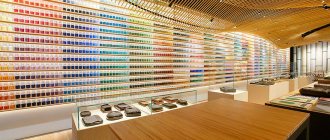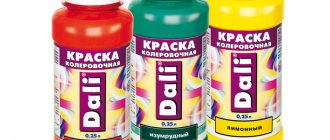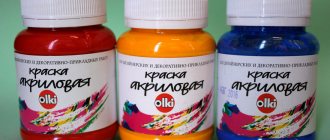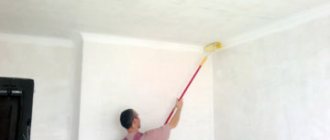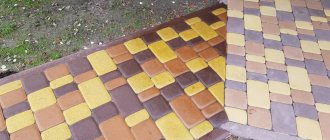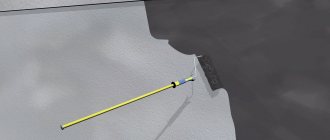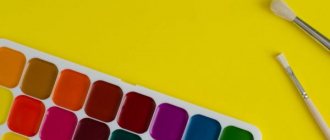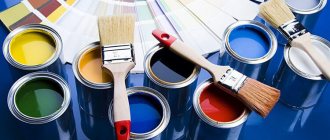Updated: 03/06/2021 13:14:15
Expert: Konstantin Borisovich Polyakov
*Review of the best according to the editors of expertology.ru. About the selection criteria. This material is subjective in nature, does not constitute advertising and does not serve as a purchase guide. Before purchasing, consultation with a specialist is required.
Acrylic paints are a popular finishing material today. They are used for painting interior and exterior surfaces, for finishing ceilings, walls, floors, facades and other substrates. The popularity of acrylic paints is explained by their versatility of use. They can be applied to concrete, wood, brick, foam blocks, and plastered surfaces. In addition, acrylic is easy to work with, so a DIYer can handle painting without any problems. To choose acrylic paint for renovation work, you should listen to the recommendations of our experts.
How to choose acrylic paint
Compound
. Acrylic paints have many useful qualities that arise from its composition.
- The basis of the material is acrylic-based monomers, which hold additives and pigments well. Auxiliary monomers are added to the base composition, the concentration of which reaches 10%.
- Water or organic compounds are used as a solvent. When purchasing interior paint, you should give preference to more environmentally friendly water-based materials. Facade paints most often contain an organic solvent.
- The purpose of modifying additives is to improve coverage, increase drying speed, and make the coating more durable.
- Pigments are responsible for color and coverage. When choosing facade paint, an important characteristic is the resistance of pigments to ultraviolet radiation and moisture.
Types of acrylic paints.
Depending on their purpose, acrylic paints can be divided into several groups.
- Facade paints generally include all acrylic products for outdoor use. With their help, it is possible to decorate the walls of houses, outbuildings, fences, as well as garden decor. After drying, the coating becomes resistant to moisture, and the surfaces can be washed directly with a hose.
- Interior paints and varnishes are used for interior work. They can be used not only in residential premises, but also in utility rooms, in factory workshops or unheated warehouses. The main thing is that the painted surface is not exposed to precipitation and ultraviolet radiation. A distinctive feature of interior paints is their environmental friendliness and safety for human health.
- Special acrylic-based paints contain special components that make the coating resistant to biodestruction or high temperatures. Such materials are used in damp rooms; they are applied to radiators of the heating system.
Application technology
. To get a smooth and beautiful surface after painting, you should follow the application instructions.
- Before painting, wood must be thoroughly sanded and then dust removed from the surface.
- Concrete, brick and stone foundations require thorough cleaning.
- Rust and stains are removed from the metal surface; organic degreasers are used for treatment.
- Before painting, it is better to prime all surfaces with a compound from the same manufacturer as the paint.
We have selected the 10 best acrylic paints for review. All of them are sold in the Russian retail chain. When compiling the rating, the opinion of the expert community and reviews of domestic consumers were taken into account.
Paints for facade works
Sikkens AlphaCoat
Once dry, it creates a matte, fine-grained textured surface. For a long time it retains not only its attractive appearance, but also its performance qualities. The elasticity and vapor permeability of the coating is at the highest level. This paint forms a reliable layer characterized by an increased level of strength. It withstands exposure to precipitation and ultraviolet rays well, and does not fade under them for a long time. Very easy to apply. The paint has good hiding power and easily hides minor defects in the base. With the help of this composition it is possible to remove excess moisture from the walls and at the same time prevent penetration into them. The increased level of elasticity helps prevent the occurrence of cracks in the event of tension or compression of the surface, as well as during significant changes in ambient temperatures.
More: Where to buy Eurocubes? TOP 5 companies in Moscow and the Moscow region
The manufacturer and experts advise applying the composition in a fairly thick layer. The paint contains no volatile organic substances, and it has virtually no foreign odor. The product is designed to work with mineral substrates - concrete, plaster, brickwork, cellular concrete, and can even be applied to a previously painted surface. If necessary, the paint can be diluted with water.
Advantages:
- Has a fine-grained structure;
- The coating is characterized by a long service life;
- It allows water vapor coming from the wall structure to pass through it;
- Elasticity indicators allow the paint layer not to crack under loads on the base.
Flaws:
- One of the most expensive on the market;
- Application by spraying is not recommended.
Sikkens AlphaCoat
Symphony Euro-Balance Facade
This water-polymer composition was originally developed to work with external surfaces made of concrete, covered with cement or lime plaster. The paint is well suited for finishing mineral fiber boards, blocks made of foam concrete and other stone surfaces. In most cases, the composition is used for painting facades and plinths of buildings for a wide variety of purposes - residential, commercial, industrial, warehouse, and so on. This paint and varnish material is resistant to cleaning and is characterized by high vapor permeability. Additionally, it can give the surface increased dirt- and water-repellent qualities. The composition contains antiseptic substances, so the surface will be reliably protected from the occurrence of fungal formations and mold.
After complete drying, a waterproof coating is formed - this factor will be very relevant for problematic buildings that are regularly exposed to precipitation. The paint consumption is not too high - one liter of composition is enough for 4-10 square meters of surface. This directly depends on the application technology, the absorbent qualities of the base, and its structure. It can be applied to the surface with a brush, roller or spray. If necessary, can be diluted with water in a maximum ratio of 1:1. The first layer dries within half an hour, re-painting can be done after 2-4 hours. The paint dries completely within 24 hours.
Advantages:
- Quite a wide scope of use;
- The composition goes well with various thermal insulation materials;
- The paint is absolutely waterproof;
- Resistant to biological damage.
Flaws:
- For acrylic paint it is relatively expensive.
Symphony Euro-Balance Facade
Tikkurila Facade Silicon
The leader of this part of our review of the best acrylic paints is made using a reinforced Facade Silicon formula. It is produced on the basis of biocidal additives that prevent the occurrence of fungi and mold. This paint is characterized by excellent moisture permeability, due to which the base continues to breathe and moisture does not accumulate in it. The silicone substances added here make it possible to perfectly protect the surface from moisture, dirt and other negative factors. The paint can be used to finish absolutely any surface. The exception is for substrates treated with silicate or lime paints or other organic coatings of an organic type. It is advisable to use the composition for treating concrete bases against processes such as carbonization or corrosion.
It is allowed to use this paint for finishing plinths and facades of residential, commercial and other types of buildings if they are made of concrete, plastered, or made of fiber cement boards. The base should be pre-prepared - completely free of dust, degrease, and cover with a layer of primer. The service life of this coating is about 20 years, and the paint layer does not require special care and maintenance.
Advantages:
- Long service life of the paint layer;
- The coating is resistant to moisture;
- The composition excellently resists the emergence and development of harmful microorganisms;
- Reasonable price.
Flaws:
- It was not revealed.
Tikkurila Facade Silicon
Rating of the best acrylic paints
| Nomination | Place | Name | Price per LITER! |
| Best Acrylic Floor Paints | 1 | Little greene Intelligent Gloss | 2 650 ₽ |
| 2 | V33 Renovation Perfection for floors and stairs | 1 536 ₽ | |
| 3 | ESKARO Floor Aqua A | 1 320 ₽ | |
| 4 | Tikkurila Betolux | 1 300 ₽ | |
| 5 | Floor enamel LAKRA acrylic | 420 ₽ | |
| The best acrylic paints for walls and ceilings | 1 | Tikkurila Magnetic | 3 862 ₽ |
| 2 | V33 Facile A Vivre for walls and ceilings | 393 ₽ | |
| 3 | TIKKURILA HARMONY | 2 133 ₽ | |
| 4 | Sikkens Alphatex SF | 1 238 ₽ | |
| 5 | Regal Select 547 Waterborne Interior Paint - Flat | 2 185 ₽ | |
| 6 | Pufas GOLD STAR 45 acrylic | 740 ₽ | |
| The best facade acrylic paints | 1 | Tikkurila Facade Silicon | 432 ₽ |
| 2 | SYMPHONY EURO-Balance Facade | 490 ₽ | |
| 3 | Sikkens Alphacoat | 1 190 ₽ | |
| 4 | VGT VD-AK-1180 facade “Snow White” | 93 ₽ | |
| 5 | TEX façade Universal matte | 247 ₽ | |
| The best acrylic paints for the kitchen and bathroom | 1 | Little greene Intelligent Matt Emulsion | 2 650 ₽ |
| 2 | Dufa Premium KeraLine 20 | 583 ₽ | |
| 3 | VGT VD-AK-1180 interior washable matte | 142 ₽ | |
| 4 | Tikkurila Euro Extra 20 moisture resistant | 533 ₽ |
Which company is best to choose?
Many manufacturers of acrylic paints produce special products. We reviewed the range of the modern market and identified several of the most reliable manufacturers.
The rating of the best acrylic paints includes compositions from Tikkurila Siro Himmea, Yaroslavl paints YARKO, Alpha Series, TEKNOS Akrylin, Tikkurila Ultra Classic, Poli-R Wandfarbe, Dulux Easy, Tikkurila Facade Acrylate, little greene Absolute Matt Emulsion, MAGPAINT Blackboardpaint, Tikkurila Joker, Dulux, Parade Classic W3 Interior and Tikkurila Luja 7.
Best Acrylic Floor Paints
When choosing acrylic paint for painting the floor, you should pay attention to such a parameter as wear resistance. To clean the floor covering, regular detergents are used; dust can be removed using a vacuum cleaner. Experts have selected several high-quality paints for finishing the floor.
Little greene Intelligent Gloss
Rating: 4.9
Acrylic floor paint from an English company has a glossy surface after drying and is easy to clean, which helps keep floor surfaces clean. The product is supplied in a base and tinted to the desired shade. The substance adheres well to metal and wood. If you need to dilute the volume or color, then use water for this. Reviews show that the paint does not have an unpleasant odor during operation.
Paint from a global brand is very common on sale, so if you want to buy it, you can find it in any hardware store. The popularity of the product is due to its economical consumption with a coverage of up to 14 m2. from one liter. Acrylic paint also dries in 4 hours, which is optimal for accelerated renovations when the room cannot be empty for a long time. Thanks to quick drying, there is less chance that someone will have time to walk on the floors, leaving marks. We recommend paint for schools, kindergartens and other institutions to carry out emergency repairs in the evening.
Advantages
- easily diluted with water;
- one liter can cover up to 14 square meters;
- fits perfectly on metal and wood;
- dries in 4 hours.
Flaws
- not suitable for painting concrete floors;
- high price.
Features of wall painting
We have already said that one of the most important stages is the stage of preparing the surface and bringing it to the desired state. First of all, to do this it is necessary to remove the old coating. This is especially true for small pieces of wallpaper that are tightly stuck. They will have to be thoroughly soaked and removed with a spatula. Now you need to go over the entire surface with a spatula or special grouting mesh and make sure that there is nothing unnecessary on it. After cleaning, the walls are thoroughly primed. After it has dried, it is necessary to evaluate the straightness of the surface and identify the presence of defects. If there are any, they need to be leveled using putty and a leveling layer must first be applied to the entire surface. After drying, the putty is thoroughly cleaned and primed again to remove dust.
If your wall is now perfectly smooth, then apply a layer of finishing putty on top, after it has completely dried,
sand it with a mesh and prime it again, and start painting. If you are not satisfied with the result, apply putty again to the problem areas and repeat the process until you get the desired result. To strengthen the base, some experts recommend gluing a layer of fiberglass before applying the finishing putty. This is not a mandatory point, but if you want to additionally reinforce the wall, then this will only be beneficial. To apply the paint itself, you will need a medium-sized flat brush, a small roller and a carriage for pouring liquid.
First, all the corners and junctions of the walls and the ceiling are well painted with a brush, after which two layers of paint are applied using a roller. A very important point - paint with a brush only once. Don't apply too many layers of paint. If the coating is too thick, it may crack. The second layer can be applied only after the first has completely dried. Sometimes smudges may form during the process. To avoid this, you need to monitor the amount of material on the tools. Do not apply too much paint and periodically wring out the roller, otherwise it will definitely drip or flow down the wall. It is better to cover the floor in front of the wall with old newspapers or film. Sometimes walls are painted not one color, but several.
If you want to maintain clear transition lines, use masking tape to do this. Stick it on the wall, separating the border of the first color, and paint the desired fragment. Once completely dry, remove the tape and stick a new strip onto the colored area, leaving a couple of millimeters untaped, and don't forget to stick the border of the next color. Paint the measured area again and continue repeating the process until you have applied all the desired shades. apply a variety of patterns to painted walls using stencils or simply draw, if your skills allow it.
It is not recommended to use the same stencil twice if the side adjacent to the wall is stained with paint. You risk damaging the coating. It’s better to stock up on the required number of sheets at once. After complete drying, your walls will delight you with their smooth, strong surface for a long time.
The best acrylic paints for walls and ceilings
When performing repair work on walls and ceilings, the most environmentally friendly water-based compounds are used. Among the main technical parameters, attention should be paid to hiding power and decorativeness. Experts liked several acrylic paints.
Tikkurila Magnetic
Rating: 4.9
Acrylic paint is available in containers from 0.5 liters and is white. The required shades are obtained by tinting. The product is intended for painting indoor walls and dries in 24 hours. If you need to make the consistency thinner, dilution with water is allowed. Users in reviews note the economical consumption of 15 m² per liter. The substance adheres well to wood, drywall, and concrete. You can paint the walls with a roller or brush, but nothing will work with a spray bottle.
The trick of acrylic coating is the presence of metal particles in the composition. After drying, the walls will be magnetic. This is convenient for attaching a calendar, photo, poster, or exchanging notes within the family. At the same time, the walls do not deteriorate, and the large area allows you to attach objects of unlimited size (unlike the surface of the refrigerator, which can accommodate 20 magnets). Although paint can be used on any wall in a room, experts recommend acrylic coating for a child's room. This will make it more fun for your child, and the surface will not be covered with numerous punctures from pins and nails.
Advantages
- can be tinted in any color;
- good adhesion to concrete, drywall, wood;
- diluted with water;
- magnets subsequently stick to the surface.
Flaws
- high price;
- not suitable for spray bottles due to metal particles in the composition;
- dries in 24 hours.
Preparing the surface for painting
Before painting the ceiling with acrylic paint, we prepare building materials for the process. Main list:
- abrasive devices (sandpaper, trowel mesh, hard brush);
- means for applying paint (roller, brush);
- tray, spatula, putty, paintwork;
- stepladder, protective material.
Preparing the ceiling for painting. Step by step: 1 step. We remove old coating (paint, wallpaper, foam), unnecessary elements (rust, mold, dust, dirt), and other substances (traces of oil, resin). Step 2. Rinse the residue with clean water and let the surface dry. Step 3. We level the ceiling area with gypsum putty and let it dry. Step 4 We sand the coating, treat it with a primer layer, and after drying, repeat the priming procedure.
It is equally important to prepare the premises itself for work. To do this, you need to ensure optimal temperature (from +20 Celsius), eliminate drafts, and reduce the percentage of humidity. To prevent paintwork materials from getting onto neighboring areas, we protect them with prepared materials (polyethylene, tape).
The best acrylic paints for the kitchen and bathroom
The kitchen and bathroom are areas with high moisture content. For paint in these rooms to last long, it must resist water penetration into its structure and allow the painted surfaces to be washed to remove dirt, mold and grease. Here are the best products that are in high demand in Russia for such specific places of operation.
Little greene Intelligent Matt Emulsion
Rating: 4.9
In this category, first place was taken by paint from the British brand Little greene. Acrylic Intelligent Matt Emulsion is formulated for wet rooms to resist water penetration into the surface and maintain deep color. The substance can be applied to drywall, wood or plaster. The consumption here is quite economical and amounts to 14 m² per liter. It is allowed to start painting work in a room with a temperature of +5 degrees. Acrylic matte paint can be tinted according to the Little greene catalog in any shade. Like other products in the series from this manufacturer, the first layer dries after 1 hour, which allows you to continue painting. Final drying occurs after 4 hours.
This is the best acrylic paint for a kitchen or bathroom because it is great at repelling dirt once it dries. The surfaces can be washed and actively pressed on them with a sponge and detergent, because the abrasion resistance here is 15 times higher than that of other matte analogues.
Advantages
- beautiful deep color;
- excellent resistance to surface contamination;
- resistance to washing;
- dries in 4 hours.
Flaws
- very high cost.
What might you need for drawing?
First of all, the artistic acrylic paints themselves. If you doubt your ability to mix different paints or are afraid of not getting “in color” when applying color, then it is better to use ready-made paint palettes, since acrylic paints are now available in about 130 colors both in tubes (tubes) and in small plastic jars -containers.
If you are just starting to paint with acrylic paints, so to speak, taking courses for beginners, try your hand as an artist with basic undiluted colors: white - black, red - blue, yellow - green, brown.
And don’t take on complex work right away, buy a regular children’s coloring book, and try to color any picture using your favorite acrylic painting technique.
This is good practice for beginners - once you learn how to work in small areas, you will understand how to use acrylic paints when painting large canvases. It is important to remember when using acrylic paints that they dry very quickly and cannot be left open!
What else you will need:
- Long brushes made of natural and synthetic hair - flat and round in different numbers. Plastic pile will be needed when working with undiluted acrylic; natural “column” or “squirrel” - for watercolor techniques.
- A set of palette knives of different sizes. A palette knife is a device that artists use to clean the palette and apply thick paints to the canvas. A kind of trowel knife made of flexible steel strip or thick plastic.
- A bottle of clean water (preferably warm). You also need a spray gun to wet the working surface so that the acrylic paint adheres better to the canvas.
- Palette. You will place some paint on it for convenience or mix paints with each other, using some as dyes or colors for others. It is very convenient and economical to use ordinary disposable plastic trays or plates. You can purchase or make a palette that will retain moisture in the paint. The whole secret is two types of paper. The first, bottom layer is one that absorbs water and is therefore always wet, the second is parchment that covers the paint on top.
- Retarder (thinner) for acrylic paints. It will not allow a polymer film to quickly form, and will make it possible to more carefully work out the drawing on paper or canvas for drawing. This “addition” will also increase the ability to spread and shade the paint and make it a little brighter. You can apply it directly into the paint, or simply on a brush. How to use them correctly is written in the instructions for use.
How to paint with acrylic paints using a palette knife? Just like with oil, applying thick paint in even layers or in a relief stroke.
Having understood the peculiarity of such application and having learned to work with a palette knife, you will appreciate its wide capabilities and will be able to work with polymer paints on wood or canvas, and even give a master class to beginners on how to use it correctly in their work so that a painting with acrylic paints turns out not only bright, but also bas-relief volumetric.
Among other things, you need to prepare:
- a large volume of water in a deep container for washing brushes;
- paper or cloth napkins and towels;
- sandpaper with grit P120;
- felt-tip pens, markers, gel pens or chanting (a glass or copper tube with a thin spout for drawing thin contour lines) to complete the drawing;
- decoupage glue;
- An airbrush can also be used if you are sure that you are using it correctly and the acrylic paint is diluted in the proper proportion;
- and, of course, the basis for painting with acrylic paints.
On video: painting space with acrylic.
